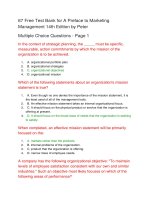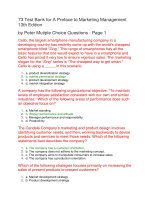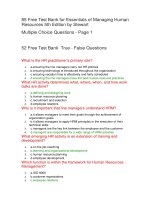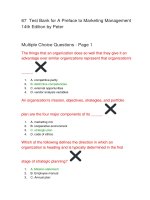67 test bank for a preface to marketing management 14th edition by peter
Bạn đang xem bản rút gọn của tài liệu. Xem và tải ngay bản đầy đủ của tài liệu tại đây (47.73 KB, 14 trang )
67 Free Test Bank for A Preface to Marketing
Management 14th Edition by Peter
Multiple Choice Questions - Page 1
In the context of strategic planning, the _____ must be specific,
measurable, action commitments by which the mission of the
organization is to be achieved.
1.
2.
3.
4.
A. organizational portfolio plan
B. organizational strategies
C. organizational objectives
D. organizational mission
Which of the following statements about an organization's mission
statement is true?
1.
A. Even though no one denies the importance of the mission statement, it is
the least used of all of the management tools.
2. B. An effective mission statement takes an internal organizational focus.
3. C. It should focus on the physical product or service that the organization is
offering at present.
4. D. It should focus on the broad class of needs that the organization is seeking
to satisfy.
When completed, an effective mission statement will be primarily
focused on the:
1.
2.
3.
4.
A. markets rather than the products.
B. internal problems of the organization.
C. product that the organization is offering.
D. narrow class of employee needs.
A company has the following organizational objective: "To maintain
levels of employee satisfaction consistent with our own and similar
industries." Such an objective most likely focuses on which of the
following areas of performance?
1.
2.
3.
4.
A. Market standing
B. Worker performance and attitude
C. Manager performance and responsibility
D. Productivity
Which of the following defines the direction in which an organization
is heading and is typically determined in the first stage of strategic
planning?
1.
A. Mission statement
2.
3.
4.
B. Employee manual
C. Annual plan
D. Code of ethics
An organization's focus on devising methods to attract customers to
current products is called _____.
1.
2.
3.
4.
A. customer orientation
B. production orientation
C. selling orientation
D. non-profit orientation
It is important for a mission statement to be _____ because it
provides a shared sense of purpose outside the various activities
taking place within the organization.
1.
2.
3.
4.
A. internally-focused
B. product-oriented
C. motivational
D. generic
In determining its mission statement, an organization must:
1.
A. look at the business from the inside, from the point of view of the employee
and the management.
2. B. ensure that the name of the product or service it is producing is an
essential part of the organization's name.
3. C. reflect a market-driven approach by targeting a broad class of needs and
segmented target markets.
4. D. state the mission in terms of serving a generic group of clients or
customers and meeting generic, not specific, needs.
Candela Inc.'s marketing and product design involves identifying
customer needs and then working backwards to devise products
and services to meet those needs. Which of the following
statements is most likely true about Candela Inc.?
1.
2.
3.
4.
A. It does not adhere to the marketing concept.
B. It demonstrates customer orientation.
C. It aims to manipulate customers to increase sales.
D. It has a production orientation.
The Helen Mortimer Foundation is a non-profit organization that
develops marketing strategies to encourage people to stop smoking
in an effort to reduce the incidence of lung cancer. This best
exemplifies marketing for a(n) _____.
1.
2.
A. organization
B. person
3.
4.
C. cause
D. service
Which of the following changes in an organization's environment
will most likely result in the organization becoming a drifting
organization?
1.
A. The organization hires new management executives who are expected to
uphold and maintain the organization's mission.
2. B. The organization has started manufacturing low-cost products as opposed
to the luxury products that were a part of its original plan.
3. C. The organization has successful operations in ten different countries and
has decided to open market in two additional countries.
4. D. The organization has decided to promote efficient employees that adhere
to the company's mission statement instead of hiring managers.
The crux of the marketing concept is focusing on building long-term
_____, where the initial sale is viewed as the beginning step and
not as the end goal.
1.
2.
3.
4.
A. mass marketing strategies
B. product-oriented teams
C. research capabilities
D. customer relationships
According to the marketing concept, the customer will be more
satisfied and the firm will be more profitable when the:
1.
2.
3.
4.
A. organizations and customers have a long-term relationship.
B. organization's marketing process is solely product-oriented.
C. products are advertised frequently but have no clear target markets.
D. firm operates primarily through a selling orientation in the market.
The purpose of the marketing concept is to rivet the attention of
marketing managers primarily on serving broad classes of _____.
1.
2.
3.
4.
A. supplier needs
B. employee needs
C. management needs
D. customer needs
Chello Inc., the largest smartphone manufacturing company has
been selling the world's cheapest smartphone called Zing. Recently,
to increase its sales, Chello reduced the price of the phone even
further. The marketing slogan for the Zing series is "The cheapest
way to get smart." Chello Inc. is most likely using a _____ in this
scenario.
1.
A. product diversification strategy
2.
3.
4.
B. market penetration strategy
C. product development strategy
D. market integration strategy
Which of the following statements is true regarding market
penetration strategies?
1.
2.
A. They involve the creation of new products for a market.
B. They involve encouraging present customers to purchase more of a
product.
3. C. They involve diversifying into an unrelated business.
4. D. They involve marketing to new customers.
Run With Scissors Inc., a hair salon, advertises its trendy and
affordable offerings primarily through the use of social media. The
type of strategy the hair salon uses can best be classified as
marketing for a(n) _____.
1.
2.
3.
4.
A. product
B. service
C. cause
D. organization
Market development strategies involve:
1.
2.
3.
4.
A. increasing the sale of existing products to present customers.
B. finding new customers for its present products.
C. directing new products to present customers.
D. leading an organization into entirely new and unrelated businesses.
Which of the following statements is true of organizational
objectives?
1.
A. Organizational objectives should reflect the organization's finances, rather
than its commitment to the customers.
2. B. Organizational objectives are not considered to be dominant necessities to
carry out the organizational mission.
3. C. Organizational objectives are specific, measurable, action commitments on
the part of the organization.
4. D. Organizational objectives are distilled to arrive at a specific and achievable
organization mission.
The things that an organization does so well that they give it an
advantage over similar organizations represent that organization's
_____.
1.
2.
3.
4.
A. competitive parity
B. distinctive competencies
C. external opportunities
D. vendor analysis variables
Zest Sports Inc. manufactures sports goods and recently introduced
a new line of sportswear for children between the ages of seven
and ten years. The marketing team envisions an entirely new
marketing strategy to create exchange for its new line of
sportswear. This best exemplifies _____.
1.
2.
3.
4.
A. service marketing
B. product marketing
C. cause marketing
D. place marketing
An organization's mission, objectives, strategies, and portfolio plan
are the four major components of its _____.
1.
2.
3.
4.
A. marketing mix
B. cooperative environment
C. strategic plan
D. code of ethics
Identify the accurate statement regarding an effective mission
statement.
1.
A. It should focus on the physical product that the organization is offering at
present, not on the external forces that the organization is seeking to satisfy.
2. B. It should focus on public relations as its primary purpose.
3. C. It should not consider the critical characteristics and events of the past.
4. D. It should provide guidance to employees and managers in geographically
dispersed units.
The principal task of the marketing function operating under the
marketing concept is to _____.
1.
2.
A. focus on selling products to a particular class of customers
B. increase the company's rate of production and devise methods to
aggressively attract consumers to purchase products
3. C. find effective and efficient means of making the business do what suits the
interests of customers
4. D. find ways to manipulate customers to do what suits the interests of the firm
The mission statement of a company should primarily have a(n)
_____.
1.
2.
3.
4.
A. product focus
B. external focus
C. internal focus
D. selling focus
Formulating a strategy based on distinctive competencies provides
an organization with a unique benefit that allows the organization to
_____.
1.
2.
3.
4.
A. gain advantage over its competitors
B. retain its product-oriented focus for growth
C. rely on the critical characteristics and events of the past
D. focus on selling rather than on customer satisfaction
An organization's mission statement must be _____ to be able to
provide direction and guidelines to management when they are
choosing between alternative courses of action.
1.
2.
3.
4.
A. challenging
B. broad
C. generic
D. specific
Run for the Cure is an annual marathon that raises money for
conducting research on breast cancer. Marketers advertise through
the local media to attract participants and volunteers for the event.
Which of the following types of marketing is depicted in this
scenario?
1.
2.
3.
4.
A. Place marketing
B. Product marketing
C. Organization marketing
D. Service marketing
Winter Head is a firm that manufactures woolen blankets. The
manufacturer claimed its blankets made from the softest wool and
were so finely stitched that consumers wanted to include them in
their inheritance. The company was proud of its product quality and
formulated its mission statement based on it. What could potentially
be wrong with such a mission statement?
1.
2.
3.
4.
A. The firm had an external focus.
B. The firm focused on the market for its high-quality products.
C. The firm focused on the product rather than on its market.
D. The firm defined the company in terms of its marketing capabilities.
An organization's mission statement is described as not ruling out
any opportunity management might wish to pursue. This mission
statement is most likely to be _____.
1.
2.
A. too distinctive
B. incomplete
3.
4.
C. too broad
D. too specific
Which of the following is the first component of the strategic plan?
1.
2.
3.
4.
A. Organizational objectives
B. Organizational strategies
C. Organizational mission
D. Organizational portfolio plan
Which of the following is a guideline for implementing the marketing
concept?
1.
2.
3.
4.
A. Define quality for the customers.
B. Manage for sales volume, not profit.
C. Target customers precisely.
D. Make advertising the guiding star.
67 Free Test Bank for A Preface to Marketing
Management 14th Edition by Peter Multiple Choice
Questions - Page 2
Which of the following statements is true of strategic planning in
well-managed institutions?
1.
A. Strategic planning is clearly a top management responsibility and does not
require the active participation of marketing managers.
2. B. Planning done in the functional areas of the organization should be
independent of the strategic plan.
3. C. There is no direct relationship between strategic planning and the planning
done by marketing team.
4. D. Marketing executives are involved in the strategic planning process as they
influence the process by providing important inputs.
Healthline is a brand of incontinence products. Healthline products
sell for $5 less than their rival brand, Depends. According to
Michael Porter's model, Healthline is most likely using a _____
strategy to market its products.
1.
2.
3.
4.
A. differentiation
B. product development
C. market development
D. cost leadership
A cross-functional team responsible for the creation of its
company's marketing plan had to make adjustments to the
marketing plan since the plan failed to meet the determined
objectives. This implies that the cross-functional team is:
1.
2.
3.
4.
A. controlling the marketing plan.
B. redefining the organizational mission.
C. implementing the marketing plan.
D. altering the organizational portfolio plan.
The final step in controlling an implemented marketing plan is:
1.
2.
3.
4.
A. performing marketing tasks.
B. comparing results of the marketing plan with objectives.
C. measuring the results of the marketing plan.
D. deciding whether the marketing plan is achieving objectives.
While choosing an appropriate strategy to establish competitive
advantage, management should choose an organizational strategy
that:
1.
A. allows the organization to practice the strategy of differentiation, rather than
cost leadership.
2. B. try to succeed by following all strategies and trying to be all things to all
people.
3. C. bears consistency with the organization's mission and capitalizes on its
distinctive competencies.
4. D. empowers the organization to grow without creating new products or
entering new markets.
_____ are methods used to determine how resources should be
allocated among the various strategic business units (SBUs) in an
organization.
1.
2.
3.
4.
A. Portfolio models
B. Matrix models
C. Variable models
D. Vector models
When using a cost leadership strategy, a firm is most likely to offer:
1.
2.
3.
4.
A. a standard, no-frills product.
B. a highly-differentiated product.
C. a prestige product.
D. an expensive product of superior design and quality.
A diversification strategy involves:
1.
2.
3.
4.
A. marketing new products to an existing customer base.
B. seeking new customers for existing products.
C. increasing the sale of present products to present customers.
D. seeking new products for customers not currently being served.
Which of the following observations pertains to strategic business
units (SBUs)?
1.
A. They are provided resources from outside the organization to which they
belong.
2. B. They have centralized management, no competitors, and little autonomy.
3. C. They are organizations that have come together to achieve a common
goal.
4. D. They can be planned independently of the other businesses of the total
organization.
Once the marketing objectives have been established during
marketing planning, the next step is the _____.
1.
2.
3.
4.
A. selection of the target market
B. identification of investors' needs
C. identification of the competing firms in the market
D. determination of the marketing mix
The cooperative environment includes:
1.
A. all firms and individuals who have a vested interest in accomplishing the
firm's objectives.
2. B. primarily other firms in the industry that rival the organization for both
resources and sales.
3. C. the attitudes and reactions of the general public, social, and business
critics.
4. D. the marketing department's past, present, and future situations.
What is indicated by the cross-functional perspective in strategic
planning?
1.
A. Management action in all functional areas of an organization provide a
blueprint for strategic planning.
2. B. All functional area plans should be derived from the strategic plan while at
the same time contributing to the achievement of it.
3. C. Objectives and strategies identified in the strategic plan are not related to
other objectives and strategies at higher and lower levels of the organization.
4. D. Objectives and strategies from the functional areas in an organization
should be translated into objectives and strategies for the strategic plan.
The final step of marketing planning is _____.
1.
2.
3.
4.
A. selecting the target market
B. developing the market mix
C. establishing objectives based on the organizational mission
D. determining performance objectives for individual members of the
marketing team
Using a competitive advantage strategy based on _____, a firm
seeks to be unique in its industry or market segment along
particular dimensions that the customers value.
1.
A. market penetration
2.
3.
4.
B. cost leadership
C. market development
D. product differentiation
Which of the following organizational growth strategies aims to find
new customers for its present products?
1.
2.
3.
4.
A. Customer retention strategy
B. Product differentiation strategy
C. Market development strategy
D. Market penetration strategy
If a firm chooses to succeed by building long-term relationships with
the firm's customers by offering either the best price, best product,
or best service, it implies that the firm's organizational strategy is:
1.
2.
3.
4.
A. based on competitive parity.
B. based on value.
C. based on products and markets.
D. based on selling.
Which of the following organizational growth strategies involves the
creation of new products?
1.
2.
3.
4.
A. Diversification strategy
B. Cost leadership strategy
C. Market development strategy
D. Market penetration strategy
Which of the following is the greatest advantage of strategic
planning with a cross-functional team?
1.
A. It ensures that strategic planning remains exclusively a top-management
responsibility.
2. B. It helps the organization arrive at a strategic plan directly from the
functional area plans.
3. C. It allows the team members to consider a situation from a number of
viewpoints.
4. D. It improves the cross-cultural relations between employees.
Which of the following is an organizational strategy based on
competitive advantage?
1.
2.
3.
4.
A. Cost leadership strategy
B. Market differentiation strategy
C. Market diversification strategy
D. Product development strategy
Which of the following represents the final phase of the strategic
planning process?
1.
2.
3.
4.
A. Creating an organizational mission
B. Formulating an organizational portfolio plan
C. Setting organizational objectives
D. Creating organizational strategies
The _____ includes the attitudes and reactions of the general
public, social and business critics, and other organizations, such as
the Better Business Bureau.
1.
2.
3.
4.
A. competitive environment
B. political environment
C. social environment
D. legal environment
Employees from different departments such as marketing,
production, finance, and human resources are brought together to
form a team responsible for creating a strategic plan to serve
customers. This is an example of a _____.
1.
2.
3.
4.
A. cross-cultural team
B. cross-functional team
C. traditional team
D. top-management team
A product development strategy:
1.
2.
A. involves creating new products for customers not currently being served.
B. offers an new and improved version of an existing product to its present
customers.
3. C. involves merely introducing a product to a new market.
4. D. deals with developing a production plan for a product.
Which of the following is most likely to comprise the cooperative
environment of a firm?
1.
2.
3.
4.
A. A rival firm
B. A non-profit organization that the firm donates funds to
C. A government that is imposing restrictions on trade and commerce
D. A supplier who has been chosen as the firm's single source
The removal of tariffs on the import of Canadian lumber will
adversely affect the U.S. lumber industry because Canada is able
to produce lumber much more inexpensively than the U.S. This tariff
removal is an example of how the _____ environment can affect
businesses.
1.
2.
3.
A. cooperative
B. functional
C. social
4.
D. legal
Beryl Toys makes toys for children of ages three and above, while
Lobster-Price makes toys for infants. In 1999, Beryl Toys acquired
Lobster-Price for $1.1 billion. This acquisition gave Beryl Toys a
new product line aimed at the younger siblings of its current target
market. In this scenario, Beryl Toys has most likely implemented a
_____ strategy.
1.
2.
3.
4.
A. diversification
B. product differentiation
C. market development
D. market penetration
The first step in controlling an implemented marketing plan is:
1.
2.
3.
4.
A. comparing the results of the marketing plan with the objectives.
B. deciding whether the marketing plan is achieving the objectives.
C. formulating a new marketing plan.
D. measuring the results of the marketing plan.
The strategic plan at Steve Walden Inc. helps in the creation of
functional area plans for the production, human resource, finance,
and technology functions. This best demonstrates the process of:
1.
2.
3.
4.
A. market diversification.
B. product-related diversification.
C. cross-functional strategic planning.
D. marketing planning.
The _____ for a soft drink manufacturer would include other
manufacturers of soft drinks, fruit juices, bottled water, sports
drinks, caffeine-free colas, and dairy beverages.
1.
2.
3.
4.
A. competitive environment
B. technological environment
C. cooperative environment
D. economic environment
Elite Inc. began as a brand of luxury clothing and accessories
targeted at affluent working women. However, it altered its offerings
to include a large proportion of standard clothes at cheaper prices
when the country was faced with severe recessionary pressures. In
this scenario, which of the following did Elite primarily respond to by
changing its offerings?
1.
2.
A. The legal environment
B. The competitive environment
3.
4.
C. The cooperative environment
D. The economic environment
Which of the following is the first step in marketing planning?
1.
2.
A. Stating standards of performance or tasks to be achieved by given dates
B. Selecting the groups or segments of potential customers the firm is going
to serve
3. C. Analyzing the different elements of the marketing mix
4. D. Identifying the market with the greatest potential
_____ is the step of the marketing management process that
involves analyzing the position of the marketing division of the firm
in terms of its past, present, and future condition.
1.
2.
3.
4.
A. Situation analysis
B. Vendor analysis
C. Post-hoc segmentation analysis
D. New product analysis
The _____ involves a set of controllable variables that must be
managed to satisfy the target market and achieve organizational
objectives.
1.
2.
3.
4.
A. demographic profile
B. mission statement
C. organizational history
D. marketing mix
Which of the following statements best describes the role of
marketing executives in the strategic planning process?
1.
A. The marketing executives must always be aware of what the process of
strategic planning involves as well as the results.
2. B. The marketing executives should make plans that are independent of the
strategic plan.
3. C. The marketing executives receive suggestions from the strategic planning
team and implement the suggestions relating to customers, products, and
middlemen.
4. D. The marketing executives are not involved in the strategic planning process
because this process is the sole responsibility of top management.
A firm has chosen to create an organizational strategy based on
differentiation. Which of the following is the firm's next step in the
strategic planning process?
1.
2.
3.
4.
A. Identifying the marketing mix
B. Creating an organizational mission
C. Setting organizational objectives
D. Formulating an organizational portfolio plan









